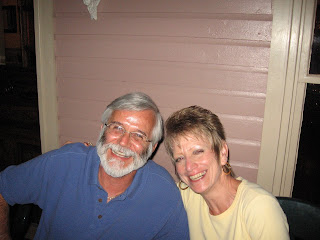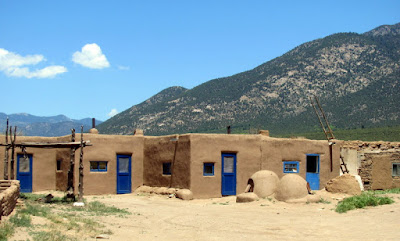The Plaza in Santa Fe is the site of the Palace of the Governors, the oldest continuously occupied public buildings in the US. The sidewalk in front of the palace is a market where Native Americans sell their jewelry and crafts.
The San Miguel Mission, built between 1600 and 1646, is considered by many to be the oldest church in the country.
The Barrio de Analco house, built in 1612, is the oldest in the city and possibly the oldest structure in the US.
Loretto Chapel is famous for its "miraculous staircase," a spiral stairway that does two 360 degree turns and was built with wooden pegs and no center support. The original stairs did not have a railing and was only attached to the floor and the choir loft.
When we were in Taos, Flower Basket recommended we visit the Puye Cliff Dwellings, the ancestral home of the Santa Clara Pueblo people. These dwellings are different because they were constructed with stones carved from the soft volcanic material of the hillside. Above are the ruins of a reconstruction from the early 1900's.
The back rooms of the dwelling were carved into the soft stone on the side of the cliff. The large holes are the doors and the small holes are where the roof rafters would have been inserted.
At the end of our tour we learned that it was our guide Mike Moquino's last tour as he was leaving to spend more time making pottery with his wife Jennifer. Their work is in great demand and has been displayed in several museums including the Smithsonian. Here is a link to see their work.
Mike explained that one way to determine the age of pottery shards is by the type of clay used during a certain period of time. He made the arrowhead. A lizard along the trail. The circle on the wall was part of a celestial clock that showed when the seasons changed.
Looking into a room of an old home. You can still see the plaster on the walls. The back areas were used for storage. Sometimes these small areas were filled with emergency supplies and plastered over. Recently one was discovered intact, which has lead to vandals drilling into the walls of unexplored dwellings looking for treasures.
On the top of the mesa are the ruins of the pueblo that was reconstructed after it was excavated by an archaeologist in the early 1900's This area has been used more recently as a movie set. Mike and Jennifer have had cameo roles in a couple of movies that were shot here.
Nanc climbing out of a kiva. The kiva was used by the Puebloans for religious ceremonies. When the Spanish controlled this area and worked to convert them to Catholicism they often built their churches over the kivas so they could not be used. The Puebloans responded by building new kivas and furnishing them as homes to fool the fools.
We were in Santa Fe for the annular eclipse and I got this lucky shot with the suns double reflection. We were just a bit off the center line to get the full ring of fire.
New Mexico not only has the nation's oldest capitol building, but also the newest which was built in 1966. To fit into the cities low profile the capitol is only three stories high. We have visited a few capitol buildings in our travels and find each has unique aspects. The unique aspect of this building is its extensive collection of works from contemporary artists who live and work in New Mexico.
While walking around the capitol we went to the governors office and after talking with the receptionist about the building and our travels we got a surprising inside look. She took us into the the New Mexico government's Cabinet Room to show us the governor's view of the city. It shows the low profile of the city with St. Francis Cathedral being the highest building.
The building is built in the shape of the Zia sun symbol that is also on the state flag. The circle represents the sun and the four lines on four sides represent the points of the compass, the seasons, the periods of each day, the seasons of life and the four sacred obligations of life. Also shown here are a couple works of art that are displayed at the capitol.
On our last day in Santa Fe there was a wonderful sunset over the city. It took us a while to get to Santa Fe. The area sure lived up to our expectations and is well worth a visit.























































